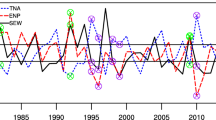Abstract
Ocean surface winds observed by the Quick Scatterometer (QuikSCAT) satellite prior to the geneses of 36 tropical cyclones (TCs) in the South China Sea (SCS) are investigated in this paper. The results show that there are areas with negative mean horizontal divergence around the TC genesis locations three days prior to TC formation. The divergence term [−(f+ζ)(∂u/∂x+∂v/∂y)] in the vorticity equation is calculated based upon the QuikSCAT ocean surface wind data. The calculated mean divergence term is about 10.3 times the mean relative vorticity increase rate around the TC genesis position one day prior to TC genesis, which shows the important contributions of the divergence term to the vorticity increase prior to TC formation. It is suggested that criteria related with the divergence and divergence term be applied in early detections of tropical cyclogenesis using the QuikSCAT satellite data.
Similar content being viewed by others
References
Bliven, L. F., H. Branger, P. W. Sobieski, and J. P. Giovanageli, 1993. An analysis of scatterometer returns from a water agitated by artificial rain. Int. J. Remote Sens., 14: 2315–2329.
Charney, J. G., and A. Eliassen, 1964. On the growth of the hurricane depression. J. Atmos. Sci., 21: 68–75.
Chen, L. S., and Y. H. Ding, 1979. An Introduction to the West. Pacific Ocean Typhoons. Science Press, Beijing, China, 400–490 (in Chinese).
Chelton, D. B., M. G. Schlax, M. H. Freilich, and R. F. Milliff, 2004. Satellite measurements reveal persistent small-scale features in ocean winds. Science, 303: 978–983.
Emanuel, K. A., 1986. An air-sea interaction theory for tropical cyclones. Part I: Steady-state maintenance. J. Atmos. Sci., 43:585–604.
Freilich, M. H., and R. S. Dunbar, 1999. The accuracy of the NSCAT-1 vector winds: comparisons with NDBC buoys. J. Geophys. Res., 104: 11 231–11 246.
Gray, W. M., 1968. Global view of the origin of tropical disturbances and storms. Mon. Wea. Rev., 96: 669–700.
Gray, W. M., 1998. The formation of tropical cyclones. Meteorol. Atmos. Phys., 67: 37–69.
Katsaros, K. B., E. B. Dunbar, P. Chang, and W. T. Liu, 2001. QuikSCAT’s SeaWinds facilitates early identification of tropical depressions in 1999 hurricane season. Geophys. Res. Lett., 28: 1043–1046.
Lau, K. H., Z. F. Zhang, H. Y. Lam, and S. J. Chen, 2003. Numerical simulation of a South China Sea typhoon Leo (1999). Meteorol. Atmos. Phys., 83: 147–161.
Lee, C.-S., Y.-L. Lin, and K. W. Cheung, 2006. Tropical cyclone formations in the South China Sea associated with the Mei-Yu front. Mon. Wea. Rev., 134: 2670–2687.
Li, T., B. Fu, X. Ge, B. Wang, and M. Peng, 2003. Satellite data analysis and numerical simulation of tropical cyclone formation. Geophys. Res. Lett., 30(21), 2122, doi: 10.1029/2003-GL018556.
Liu, K. S., and J. C. L. Chan, 1999. Size of tropical cyclones as inferred from ERS-1 and ERS-2 data. Mon. Wea. Rev., 127:2992–3001.
McBride, J. L., 1995. Tropical cyclone formation. Global perspectives on tropical cyclones. Tech. Doc. WMO/TD No. 693, World Meteorological Organization, Geneva, Switzerland, 63–105.
Ramage, C. S., 1974. The typhoons of October 1970 in the South China Sea: intensification, decay and ocean interaction. J. Appl. Meteor., 13: 739–751.
Sharp, R. J., M. A. Bourassa, and J. J. O’Brien, 2002. Early detection of tropical cyclones using seawinds-derived vorticity. Bull. Amer. Meteor. Soc., 83: 879–889.
Sobieski, P., C. Craeye, and L. F. Bliven, 1999. Scatterometric signatures of multivariate drop impacts on fresh and salt water surfaces. Int. J. Remote Sens., 20: 2149–2166.
Wang, L., C. H. Fung, and K. H. Lau, 2007a. The upper ocean thermal structure and the genesis locations of tropical cyclones in the South China Sea. J. Ocean Univ. Chin., 6(2):125–131.
Wang, L., K. H. Lau, C. H. Fung, and J. P. Gan, 2007b. The relative vorticity of ocean surface winds from the QuikSCAT satellite and its effects on the geneses of tropical cyclones in the South China Sea. Tellus A, 59: 562–569.
Weissman, D. E., M. A. Bourassa, and J. Tongue, 2002. Effects of rain rate and wind magnitude on SeaWinds scatterometer wind speed errors. J. Atmos. Oceanic Technol., 19: 738–746.
Author information
Authors and Affiliations
Corresponding author
Rights and permissions
About this article
Cite this article
Wang, L., Lau, KH., Fung, CH. et al. Features of ocean surface winds observed by the QuikSCAT satellite before tropical cyclogenesis over the South China Sea. J. Ocean Univ. China 7, 241–245 (2008). https://doi.org/10.1007/s11802-008-0241-8
Received:
Accepted:
Published:
Issue Date:
DOI: https://doi.org/10.1007/s11802-008-0241-8




